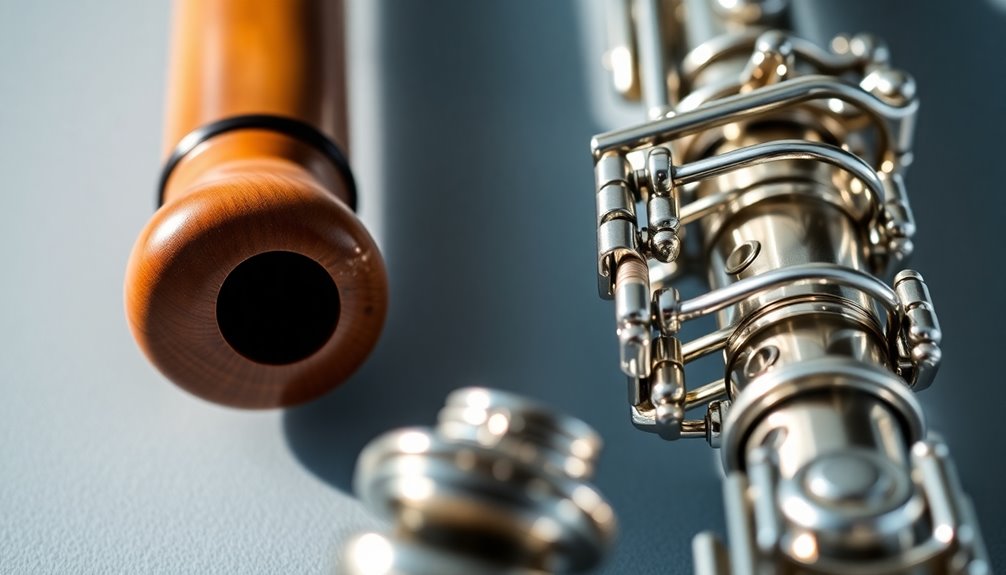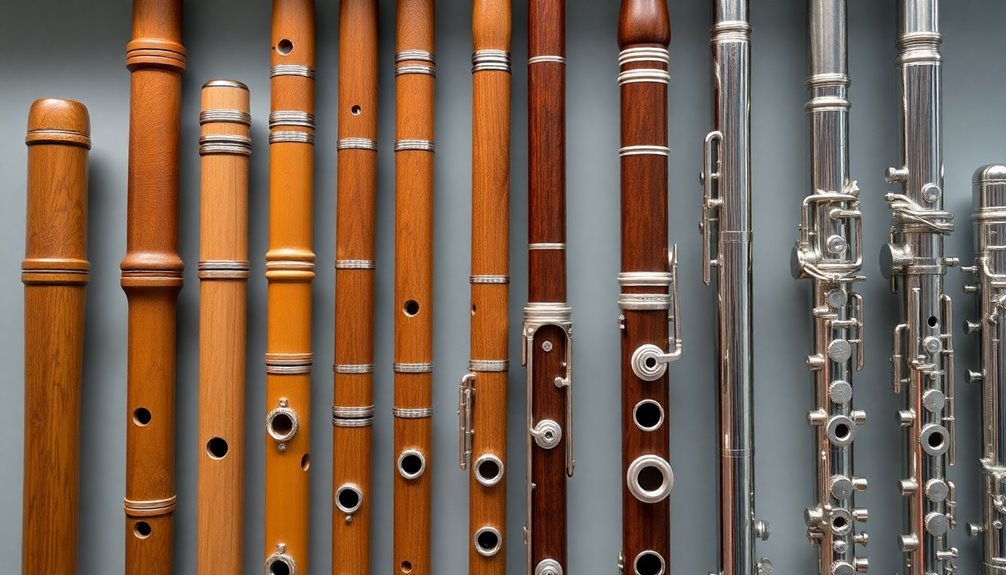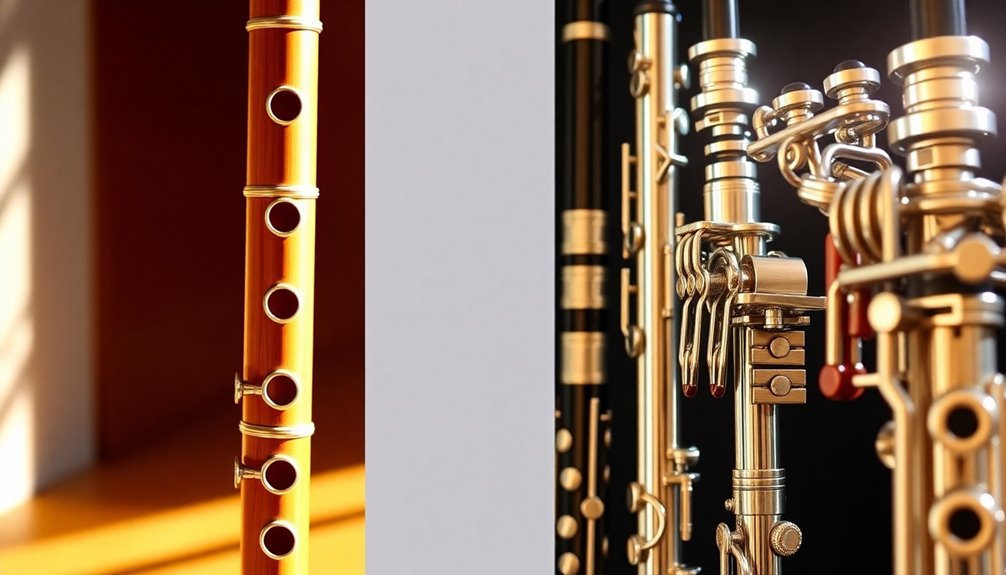The evolution of flute keywork showcases a fascinating blend of artistry and engineering. You start with basic wooden or bamboo tubes, producing sound through air vibrations. Over time, key mechanisms were introduced, considerably enhancing playability and tonal range. The 19th-century Boehm system revolutionized flute design with ergonomic adjustments, allowing for complex fingerings and greater expressive capabilities. Metal flutes emerged next, offering durability and a brighter sound, while innovations in pad technology have improved maintenance and performance reliability. As the instrument continues to evolve, future developments promise even more customizable and ergonomic features, making your musical journey even more enriching.
Key Takeaways
- Early flutes were simple tubes that produced sound through air vibration, lacking any key mechanisms for note variation.
- The 18th century introduced the first key mechanisms, allowing for greater note access and tonal control.
- The 19th century saw the development of the Boehm system, which significantly improved flute playability and ergonomic design.
- Modern flutes feature complex keywork that enhances expressive capabilities and addresses finger strain through strategic placements and adjustments.
- Future innovations promise smart keywork systems that customize settings based on player habits, further enhancing ergonomics and playability.
Early Flute Designs

Exploring early flute designs reveals a fascinating evolution in both form and function. When you investigate the history of the flute, you'll find that its beginnings are rooted in simplicity, using primitive materials such as wood, bone, and even bamboo.
These historical flutes were often crafted by hand, reflecting the resources and cultural practices of their time. Each design was a reflection of human ingenuity, adapting to the available materials and the musical needs of different societies.
The earliest flutes were fundamentally hollow tubes, producing sound through the vibration of air within them. As you examine these designs, you'll notice variations in length and diameter that directly influenced pitch and tone.
Early musicians had to experiment with finger positioning and embouchure to achieve desired notes, leading to a deep understanding of acoustics among early cultures.
Moreover, these primitive instruments were often engraved or decorated, hinting at the significance of music in community rituals and personal expression. The shift from these rudimentary designs to more refined instruments marks a pivotal moment in music history.
It's important to appreciate how these early flutes laid the groundwork for future innovations, paving the way for the complex mechanisms we see in modern instruments. For instance, the later development of the concert flute introduced new keywork that enhanced playability and range.
In understanding these early designs, you gain insight into not just the evolution of the flute, but also the cultural contexts that shaped its development. Embracing this history fosters a sense of belonging in the rich tapestry of musical heritage.
The Birth of Keywork

Emerging from the need for greater expression and technical versatility, the birth of keywork in flutes marked a revolutionary shift in instrument design. As musicians sought to expand their expressive capabilities beyond the limitations of ancient instruments, they recognized that the simple tube structure of early flutes restricted them. This realization spurred the creation of the key mechanism, which allowed players to access a wider range of notes and dynamics.
The introduction of keywork transformed the way flutes were played and perceived. By integrating keys, makers could position holes at strategic locations, enabling players to achieve more complex fingerings that previously required cumbersome adjustments. This innovation not only enhanced playability but also elevated the flute's status among orchestral instruments.
You can imagine the excitement musicians felt as they discovered the potential of this new design, bridging the gap between technical skill and artistic expression. Keywork also facilitated a more uniform sound across the instrument's range, addressing the tonal inconsistencies that plagued earlier designs. Additionally, the use of high-quality pad materials has become essential for maintaining optimal sound quality in modern flutes.
As flutes evolved, the sophistication of key mechanisms increased, leading to the development of more intricate systems that could cater to the demands of contemporary compositions. In this context, the birth of keywork wasn't just a technical advancement; it signified a collective desire among musicians to evolve their craft.
Transition to Metal Flutes

As musicians sought to further enhance their sound and performance, the alteration to metal flutes became a vital moment in the evolution of this instrument. Historically, flute changes have often mirrored broader changes in music and technology. The move from wooden instruments to metal ones, primarily silver and later gold, marked a significant turning point, allowing flutists to explore new tonal possibilities.
One of the standout metal flute advantages is its ability to produce a brighter, more focused sound. Metal flutes can project more powerfully, making them an attractive choice for orchestral and solo performance settings. This change wasn't merely about volume; it also allowed for greater clarity, enabling musicians to express intricate musical ideas more effectively.
Additionally, metal flutes offer enhanced durability compared to their wooden counterparts, reducing the risk of cracks and maintenance concerns. The high-grade stainless steel used in many metal flutes ensures rust and corrosion resistance, further enhancing their longevity.
The shift to metal also influenced keywork design. With the sturdiness of metal, key mechanisms became more complex and refined. This allowed for smoother action and more precise control, which was essential for advanced techniques and rapid passages.
As you play, you might find that the responsiveness of a metal flute can inspire you to explore new styles and repertoire that you may not have considered before.
In embracing metal, you're participating in a rich lineage of flutists who've shaped the instrument's evolution. Each note you play connects you to a tradition that values innovation and the pursuit of musical excellence.
The Boehm System Revolution

The introduction of the Boehm system represented a groundbreaking shift in flute design and playability, fundamentally altering how musicians approached the instrument. Developed by Theobald Boehm in the mid-19th century, this system introduced a complex key mechanism that enabled more ergonomic fingerings and improved intonation. You'd quickly notice the Boehm system advantages, such as easier access to high notes and a more consistent tone across the instrument's range.
However, the change wasn't without its challenges. Many traditional flutists had to adapt to the new fingerings and mechanics, often leading to a steep learning curve. The Boehm system adaptations required dedication, yet they ultimately transformed how you could express yourself musically. As a result, flutists began to explore a wider repertoire, pushing the boundaries of what was possible on the flute.
The Boehm system influence extended beyond just the instrument itself; it shaped flute pedagogy and performance practices. Teachers were now able to focus on developing expressive techniques rather than merely teaching finger placements. This shift also aligned with the evolution of beginner-friendly instruments, such as those from Yamaha and Gemeinhardt, ensuring that new players could benefit from the advancements in flute design.
This shift fostered a sense of community among flutists, as they shared experiences maneuvering through the new system.
Innovations in Pad Technology

Building on the advancements initiated by the Boehm system, innovations in pad technology have further enhanced flute performance and reliability. The development of high-quality pad materials has revolutionized how flutists experience sound production and instrument maintenance.
Today's pads, often made from synthetic materials or layered felt, provide exceptional airtight seals. This guarantees that your flute responds promptly and accurately, allowing you to focus on your artistry without disruption.
Moreover, the choice of pad materials directly influences pad longevity. Modern flutes often feature pads designed to withstand moisture and environmental changes, reducing the frequency of replacements. This durability means you can invest more time in practice and performance rather than dealing with maintenance issues.
Flutists today benefit from pads that resist wear and tear, guaranteeing that your instrument remains reliable over time. Additionally, innovations in design have led to pads that aren't only functional but also comfortable for players. High-quality noise reduction pads are essential for minimizing sound during practice sessions without sacrificing tone.
These advancements cater to a communal desire among flutists for instruments that enhance their playing experience, fostering a sense of belonging within the music community. Whether you're a beginner or an experienced player, the strides made in pad technology contribute to a more enjoyable and seamless musical journey.
Ultimately, the evolution of pad technology reflects a commitment to enhancing your flute playing experience, merging tradition with modern needs and desires. As you explore these innovations, you'll discover how they elevate your musical expression and performance.
Keywork Adjustments for Comfort

Recognizing the significance of comfort in music performance, keywork adjustments play an essential role in enhancing a flutist's experience. The ergonomic design of flute keywork is fundamental for ensuring that you can play for extended periods without discomfort. Regular cleaning prevents moisture buildup, which can also affect the overall comfort and performance of the instrument.
When adjustments are made with player feedback in mind, your overall performance improves markedly.
Here are three key areas to evaluate when assessing your flute's keywork for comfort:
- Key Height: Adjusting the height of the keys can alleviate strain on your fingers. If the keys are too high or low, you may find yourself overextending or cramping your hands.
- Key Placement: The positioning of the keys should align with your natural hand position. If you feel awkward reaching for certain keys, it might be time to rethink a repositioning based on your unique playing style.
- Pad Tension: The tension of the pads can affect how easily the keys close. If they're too stiff, it can cause fatigue when you're playing passages that require quick finger movement.
The Impact of Modern Materials

Utilizing modern materials in flute construction has revolutionized the instrument's performance characteristics and durability. You'll notice that many contemporary flutes now incorporate composite materials and lightweight alloys, which greatly enhance their playability and overall sound quality. These materials not only reduce weight but also improve resonance and projection, allowing you to express your musicality more freely.
Composite materials, for instance, offer unparalleled stability against temperature and humidity fluctuations, making them ideal for flutists who perform in various environments. Unlike traditional wood, these materials maintain their integrity over time, reducing the need for frequent maintenance. This reliability can foster a sense of confidence in your playing, knowing your instrument won't let you down during critical performances.
Lightweight alloys, such as those derived from aluminum or titanium, further contribute to the evolution of flute design. By minimizing the overall weight of the instrument, these alloys allow for greater agility and comfort, especially during extended playing sessions. You'll likely find that you can move between notes with more ease, which can be especially beneficial in fast-paced passages.
Moreover, the use of these materials often results in enhanced key mechanisms that are both durable and responsive. This means you can focus more on the music rather than worrying about the mechanics of your flute. Additionally, features like open-hole design allow for better control of dynamics and timbre, further enhancing the player's experience.
As you explore these modern advancements, you'll likely feel a deeper connection to your instrument, knowing it's crafted with cutting-edge technology that supports your musical journey.
Contemporary Flute Design Trends

Recent trends in contemporary flute design reflect a significant shift towards increased customization and ergonomic considerations, catering to the diverse needs of modern flutists. As you investigate this evolving landscape, you'll notice how manufacturers are prioritizing both comfort and aesthetic appeal, leading to a richer playing experience.
Here are three key trends shaping contemporary flute design:
- Ergonomic Features: Flute makers are integrating ergonomic designs that accommodate various hand sizes and playing techniques. This focus on comfort allows you to play for extended periods without strain, enhancing your overall performance.
- Minimalist Aesthetics: Many flutes now embrace a sleek, minimalist design, emphasizing clean lines and understated elegance. This visual simplicity not only appeals to your artistic sensibilities but also encourages a deeper connection to the instrument itself, making it a true extension of your musical expression.
- Customizable Options: The rise of customizable flutes lets you tailor your instrument to your unique preferences. From key placements to material choices, you can create a flute that feels personal and perfectly suited to your playing style.
These trends highlight a collective effort to enhance the flute-playing experience, ensuring that each musician can find an instrument that resonates with their individual identity. Additionally, the incorporation of premium materials like silver and gold has significantly impacted the tonal richness and overall quality of modern flutes.
As you explore contemporary flute designs, you'll discover not only a commitment to functionality but also a celebration of artistry that invites you to become part of a vibrant community of flutists.
Future Directions in Flute Keywork

As the landscape of flute design continues to evolve, the future directions in flute keywork are set to reflect an even deeper integration of innovation and player-centric design.
You'll likely see advancements in smart keywork systems, which promise to enhance your playing experience by offering customizable settings tailored to your unique style. Imagine having a flute that can adjust its key response based on your playing habits or preferences, all thanks to integrated sensors and smart technology.
Digital flutes are also on the rise, allowing for a seamless blend of traditional craftsmanship with modern technology. These instruments could feature built-in tuners or metronomes, giving you instant feedback and aiding your practice sessions. The potential for app connectivity means you could control your flute's features from your smartphone, enabling you to share settings with fellow musicians or access a library of sound profiles.
Moreover, the future of flute keywork will likely prioritize ergonomic designs. You'll appreciate innovations that reduce finger fatigue, allowing for longer practice sessions without discomfort. As manufacturers focus on lightweight materials and streamlined mechanisms, you'll find that the flutes of tomorrow won't only look stunning but also allow for effortless playability. Additionally, incorporating essential tools for flute musicians like tuners and metronomes will further enhance your practice experience.
In this evolving landscape, you're not just a player; you're part of a community that values progression and connectivity. The future of flute keywork is bright, and it's exciting to think about how these advancements will resonate within your musical journey.
Frequently Asked Questions
What Materials Are Modern Flutes Typically Made From?
Modern flutes typically use metal alloys like silver, gold, or nickel for their bodies, providing durability and a bright, resonant sound.
You'll also find wood options, such as grenadilla or bamboo, which offer a warmer, mellower tone.
Each material influences your playing experience and sound quality, allowing you to choose one that resonates with your style.
Understanding these options helps you connect with other musicians who share your passion for flute performance.
How Do I Choose the Right Flute for My Skill Level?
Choosing the right flute for your skill level is essential. If you're a beginner, look for beginner flutes that offer simplicity and ease of play, often featuring fewer keys and lighter materials.
As you progress, you might want to explore flutes with advanced features, like offset G keys or different headjoint options, which enhance tonal quality and playability.
Consider your goals and try different models to see which feels right for you.
What Maintenance Is Required for My Flute's Keywork?
To keep your flute's keywork in top shape, regular maintenance is essential.
Start with keywork cleaning, using a soft cloth to wipe away moisture and dirt after each use. You should also apply lubrication techniques to the springs and pads every few months to guarantee smooth operation.
Don't forget to check for any alignment issues or loose screws.
Can I Customize My Flute's Keywork for Personal Preferences?
Ever wonder how much better your playing could be with custom keywork options?
You can absolutely customize your flute's keywork for personalized flute adjustments that fit your unique style. Many manufacturers offer modifications like alternative key placements or specialized pads to enhance comfort and response.
How Does Climate Affect the Performance of Flute Keywork?
Climate markedly impacts your flute's keywork performance. High humidity can cause metal components to expand, leading to sticky keys and sluggish response.
Conversely, dry conditions might shrink pads and create gaps, affecting sound quality.
You'll notice these humidity effects more during seasonal changes, so it's essential to maintain a stable environment for your instrument.
Regularly checking your flute's condition can help guarantee it performs at its best, allowing you to play with confidence and ease.
Conclusion
In exploring flute keywork's fascinating evolution, you see how simple structures transformed into sophisticated systems. This journey, marked by meticulous mechanics and modern materials, enhances your playing experience. As you embrace these developments, you'll appreciate the artistry and engineering that elevate each note. Future innovations promise even greater wonders, ensuring that flutists continue to find fresh freedom and finesse in their music. The flute's journey reflects a harmonious blend of history, creativity, and craftsmanship.






